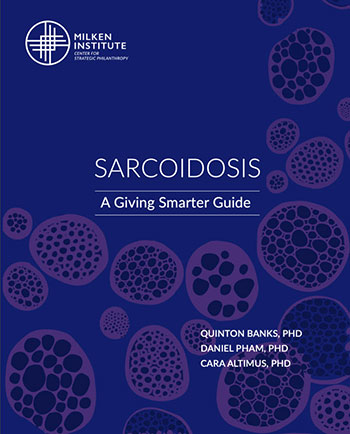Breakthrough Sarcoidosis Initiative
The Ann Theodore Foundation Breakthrough Sarcoidosis Initiative (ATF-BSI) is a competitive grants program focused on understanding the underlying biology of sarcoidosis, an immune dysregulation condition. The ATF-BSI is one of the largest investments in sarcoidosis basic science and has the potential to accelerate the speed at which new discoveries and therapies are made.
Giving Smarter Guide
In 2021, the Ann Theodore Foundation partnered with the Milken Institute’s Center for Strategic Philanthropy, which advises philanthropists and foundations seeking to develop and implement transformative giving strategies, to develop and distribute Sarcoidosis: A Giving Smarter Guide. This seminal guide laid out the critical need to better understand the disease of sarcoidosis, as well as several promising opportunities for philanthropy to step in and help support progress in this field.
Our Response
The ATF-BSI was developed in response to the Giving Smarter Guide and annually awards four to six two-year research grants led by doctorate-level investigators at qualifying research-based institutions around the world. The research studies run for two years, and the researchers present their progress and findings at an annual investigators’ meeting, as well as publish them in an open-access journal.
Funded Investigators
2024
Antje Prasse , MD, University Hospital Basel
Co-Investigator: Theresa Graalmann, MD, PhD, Twincore
This project intends to study the role of the C-type lectin receptor (CLR) in granuloma formation, a key feature of sarcoidosis pathogenesis. The research team aims to investigate how a specific CLR, Mincle, affects granuloma formation. They also plan to use novel nanotechnologies as a tool to specifically target CLRs involved in granuloma formation. These nanotechnologies might be a tool that could deliver therapeutics to the problematic cells in patients with sarcoidosis.
Michael Levy, MD, PhD, Mass General Brigham
Co-Investigator: Shamik Bhattacharrya, MD, Brigham and Women’s Hospital
This project seeks to understand the pathogenesis of neurosarcoidosis—sarcoidosis of the brain—by studying exosomes, which are small biological containers that transport proteins and other molecules. To begin profiling exosomes, Dr. Levy’s team will obtain cerebrospinal fluid from neurosarcoidosis patients and controls and study the differences in protein and gene expression within exosomes between the groups. Neurosarcoidosis is especially challenging, but this study could help find biomarkers and pharmacological targets.
Nabeel Hamzeh, MD, University of Iowa
Co-Investigator: Karin Hoth, PhD, University of Iowa
This project seeks to be the first to use neuroimaging approaches and assessments of disease burden to interrogate changes in brain activity and structure within patients with systemic sarcoidosis but without neurosarcoidosis. The team hypothesizes that systemic inflammation can lead to changes in brain metabolism, manifesting as impaired cognitive function. This project could offer insights on how sarcoidosis affects cognition.
Sean Agbor-Enoh, MD, PhD, National Heart, Lung, and Blood Institute
Co-Investigators:
- Mary Richert, MD, National Heart, Lung, and Blood Institute
- Steve Holland, MD, National Institute of Allergy and Infectious Diseases
- Wonder Drake, MD, University of Maryland, Baltimore
- Edward Chen, MD, Johns Hopkins University
- Shambhu Arya, MD, Inova Fairfax
This project intends to test the utility of cell-free DNA to diagnose, identify organ involvement, assess disease severity, and monitor treatment responses and progression in sarcoidosis. The team will also form a research working group to monitor outcomes from this study and plan future studies with the recruited patient cohort.
Wei Shi, MD, PhD, University of Cincinnati
Co-Investigator: Nishant Gupta, MD, University of Cincinnati
This project will investigate the role of lysosomes, which play a central role in a cell’s ability to break down waste, in sarcoidosis. This team aims to determine how lysosomal dysregulation contributes to sarcoidosis in patients and whether an existing drug can alleviate sarcoidosis-like symptoms in mice. These studies will help investigators assess the potential of lysosomal activity to serve as a prognostic biomarker and could potentially identify a drug that could be repurposed for sarcoidosis treatment while enabling an increased understanding of sarcoidosis biology.
2023
Lindsay Celada, PhD, Baylor College of Medicine
Celada’s project is investigating the role of two groups of immunological cells that are dysregulated in pulmonary sarcoidosis. A specific molecular pathway may lead to more severe cases of sarcoidosis, and the research group will explore this using cells from sarcoidosis patients. Understanding which sarcoidosis patients will develop severe symptoms has been a longstanding challenge in sarcoidosis, and this project could be a significant step in stratifying patient risk.
Shu-Yi Liao, MD, National Jewish Health
Liao’s project is focusing on understanding sarcoidosis small fiber neuropathy, which causes chronic pain in sarcoidosis patients and has proven difficult to track and treat. The research group seeks to study the metabolism of people living with this condition to find molecular biomarkers that can be associated with their existing clinical information. This project could help the field better assess and take care of individuals living with sarcoidosis small fiber neuropathy.
Landon Locke, PhD, Ohio State University
Locke’s project is examining how granulomas, the hallmark of sarcoidosis, can address immunological threats. While sarcoidosis can be debilitating, the granulomas that form could provide some protection against other threats, like bacteria. Using biological samples from individuals living with sarcoidosis, Locke’s team will study how sarcoidosis granulomas impact bacteria’s ability to multiply and examine a specific molecular pathway that may be involved in the process. This project can potentially reveal how granulomas form and how they interact with certain biological threats.
Jonas Schupp, MD, Hannover Medical School
Schupp’s project will develop a molecular “atlas” for sarcoidosis, which will map gene activity at the cellular level in samples from individuals living with sarcoidosis. The team will use samples from a variety of organs afflicted with sarcoidosis and compare them to other granulomatous conditions. The group plans to make this atlas a free online tool for other researchers. This tool would not only strengthen understanding of the differences between sarcoidosis in various organs and other conditions but also provide a powerful resource for the field.
Thomas Weichhart, PhD, Medical University of Vienna
Weichhart’s project is making use of a mouse model of sarcoidosis and patient samples to understand how a specific protein that integrates environmental signals, metabolism, and immune responses, mTORC1, promotes granuloma formation. The team will examine gene activity and immune cell responses using these approaches and assess sarcoidosis severity across several organs in the mouse. This project could help tease apart the complicated steps that lead to granuloma formation in sarcoidosis, potentially indicating a therapeutic target.
2022
Shaikh Atif, PhD, University of Colorado, Anschutz Campus
Atif’s project seeks to examine the role of Aspergillus nidulans, a common airborne fungus, in the development of Löfgren Syndrome (LS), an acute form of sarcoidosis. This fungus has been found in some individuals with LS and is suspected to play a role in its development. Additionally, Atif seeks to create a mouse model of lung inflammation using Aspergillus nidulans that can be used for future studies.
Jonathan Chrispin, MD, Johns Hopkins University
Chrispin’s project is set to develop an algorithm that can use heart images and electrical recordings to predict a person’s risk of sudden cardiac death. Sarcoidosis can take root in the heart, and sudden cardiac death is a serious risk once it does. As of now, there are few predictors of which individuals are more likely to suffer in this way. This project could pave the way for doctors to better understand when medical intervention is needed.
Alejandro Pezzulo Colmenares, MD, University of Iowa
Pezzulo Colmenares’ study uses a noninvasive method to assess how cells from individuals living with sarcoidosis respond at a genetic level. Typically, cells are obtained directly from the organ in question, but this study will use nasal cells to assess these questions, which is a new approach. The genetic differences seen in these cells will be related to a person’s prognosis. This study could provide a noninvasive method of learning more about sarcoidosis moving forward.
Ravi Karra, MD, Duke University
Karra’s project is focused on better understanding how granulomas, which are the hallmark of sarcoidosis, form in the condition. An immune response will be triggered that will lead to localized granuloma formation in the skin of individuals living with sarcoidosis. At different points in time, the granuloma will be sampled to understand the genetic changes that occur during granuloma formation and the genetic features that put a person at risk for developing sarcoidosis.
Laura Koth, MD, University of California, San Francisco
Koth’s project seeks to determine whether molecular factors that indicate immune cell exhaustion and genetic aging can be correlated to sarcoidosis patient outcomes. The same molecular factors have been shown to be relevant to idiopathic pulmonary fibrosis, a disease that causes lung scarring. Individuals living with lung sarcoidosis will have their lungs scanned and blood samples obtained, and a prognostic model will be developed. This model could be used to better assess who is at a higher risk for worse outcomes with lung sarcoidosis.
Li Li, MD, PhD, National Jewish Health
Li’s project sets out to better understand how genetic modifications affect sarcoidosis progression and severity. The study will obtain blood samples from individuals living with sarcoidosis and study a specific genetic alteration across the entire genome. These findings will be used to determine if modifications on certain genes convey greater risk than others and will be related to findings from idiopathic pulmonary fibrosis, which shares some clinical characteristics. This study could provide a better understanding of which genes convey more risk for sarcoidosis development and severity.

Our Grantees
We support a broad range of programs and initiatives that provide children and families with access to opportunities that help them develop, grow, and thrive.
